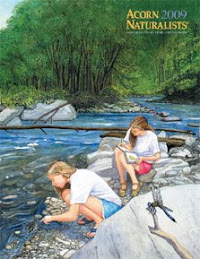 The children and I went out to our schoolyard woodland to check out the changes that had occured since fall. We wanted to see what winter had brought. Before leaving the classroom, we made our predictions. Would there be much wildlife? Where might we spot some? What about plant life? Would we see mushrooms like we had before? What about the temperature of the air? Of the soil? We gathered our notebooks, thermometers, magnifiers and hoops. We use the hoops as we use our magnifiers, to focus our attention on an area. We wanted to see both the forest and the trees.
The children and I went out to our schoolyard woodland to check out the changes that had occured since fall. We wanted to see what winter had brought. Before leaving the classroom, we made our predictions. Would there be much wildlife? Where might we spot some? What about plant life? Would we see mushrooms like we had before? What about the temperature of the air? Of the soil? We gathered our notebooks, thermometers, magnifiers and hoops. We use the hoops as we use our magnifiers, to focus our attention on an area. We wanted to see both the forest and the trees.The kids are very receptive to the gentle approach we have to studying our woodland. We define our outdoor classroom by a perimeter of special trees. We know what the limits are. We know that if we disturb a hidden habitat, we look but then carefully put things back where we found them. The students and I talk about how to probe with the ends of our pencils. No sudden moves! Our aim is to satify our curiosity respectfully.
The kids were absolutely joyful to go outside and investigate. Time flew by. In a very short time we discovered many similarities and differences from our autumn examination. Each season will bring another time for exploring the woodland looking for changes. I think this experience teaches the kids a number of science concepts but it also helps them see that the woodland is a special place of learning that must be respected as any classroom environment.
 When teachers or kids know they are scheduled for my science class, one of the questions I always hear is "Are we going outside?" It's interesting that learning outside is so novel. I think it is the best place to teach a lot of our science curriculum. Lately, students and I were studying the weather and I challenged them to design and build a weather vane. We had talked about how people used to be able to forecast the weather by looking at weather signs -- the direction of the wind, the look of the clouds, the feel of the temperature. They didn't need to tune into a TV weather report and hear from the meterologist. Checking the weather was something we knew how to do ourselves.
When teachers or kids know they are scheduled for my science class, one of the questions I always hear is "Are we going outside?" It's interesting that learning outside is so novel. I think it is the best place to teach a lot of our science curriculum. Lately, students and I were studying the weather and I challenged them to design and build a weather vane. We had talked about how people used to be able to forecast the weather by looking at weather signs -- the direction of the wind, the look of the clouds, the feel of the temperature. They didn't need to tune into a TV weather report and hear from the meterologist. Checking the weather was something we knew how to do ourselves.







